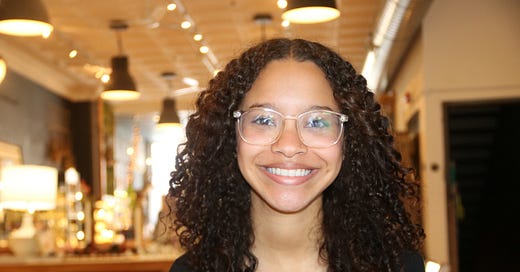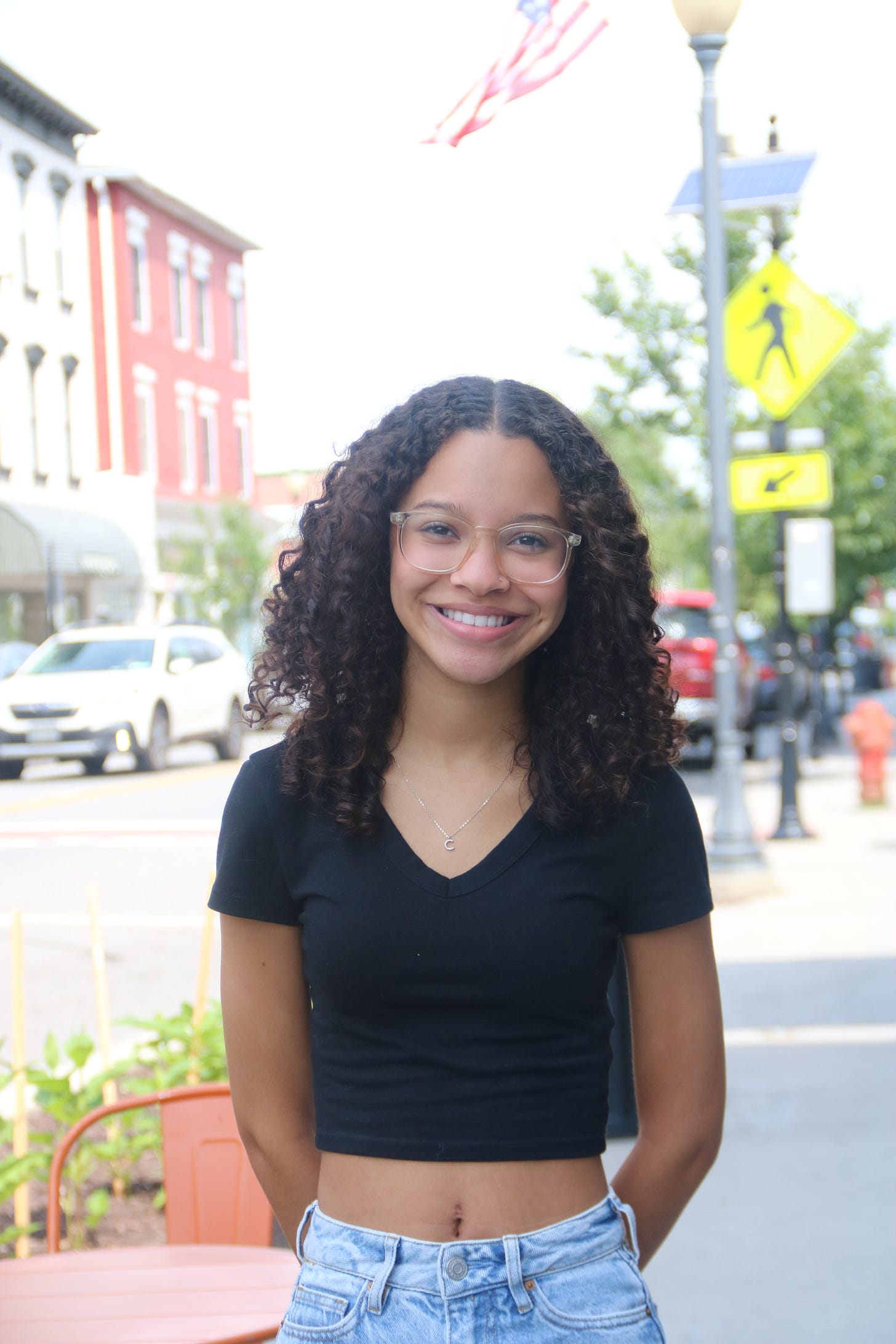On the Way to Civic Readiness in Port Jervis High School
Senior Crysti Ramos, 18, was one of 16 Port Jervis High School students awarded the New York State Seal of Civic Readiness at a time when civic knowledge among youth has declined.
Crysti Ramos, 18, sitting at Foundry 42 one morning before going to work, recalled making a transition from “shy” to sociable after she moved to Port Jervis from the Passaic area of New Jersey in eighth grade. Perhaps that shift foreshadowed the New York State Seal of Civic Readiness she recently received as a high school senior after meeting state requirements that were met by 16 Port Jervis High School students this year, although civic knowledge has been in decline among youth nationally and internationally.
“Moving was abrupt. I was sad but not for too long,” Crysti said of her beginnings at Port Jervis Middle School. “I’m not one to wallow. I thought Port Jervis was small and tight-knit, and I wasn’t part of it. I wondered how to get involved. I was shy and out of my comfort zone in middle school but not in high school. I joined clubs. I said ‘hi,’ and just talked to people.”
She had felt lonely working by herself at home during the pandemic but made efforts to connect in high school, when school normalcy gradually resumed. She joined the Junior National Honor Society online and the Port Jervis Youth Coalition, where she helped with the Halloween Parade for two years. She joined the tennis team as a freshman and stayed for three years and was a class officer for four years. Competition for officer positions was minimal, so she and a friend alternated being class president or vice president, Crysti said.
She participated in various community service activities—fundraising car washes, wrapping Christmas presents, volunteering at Brandywine Preserve as a camp counselor. She helped with the junior class semi-formal dance, arranging to have it in the high school gym to save money. She worked on decorations beginning in January, although, she said, “At first people didn’t show up.”
Later, parents and others contributed table runners, food and decorations for the “woodsy mythical theme.”
“It was a big hit and inspired the next class to have their dance in the gym” Crysti said.
She helped run a football concession stand and enthused about the senior trip to Florida.
“It was the first trip after Covid. We had a lot of fun and the seniors got closer,” she said.
She recalled the group arriving at the hotel, changing into bathing suits, jumping into the pool and playing volleyball, which became the evening ritual.
“I like big gatherings, spending time with people, talking, singing a little and dancing,” perhaps to Taylor Swift and Drake, she said.
As for social media, said Crysti, “It’s not my world,” although she does “watch Tiktoks and YouTube and scroll Instagram.”
What was in her world already was the New York State Seal of Biliteracy, which she pursued last year, with Spanish as her second language. This year she decided to pursue the NYS Seal of Civic Readiness.
According to the New York State Education Department website, “The Seal of Civic Readiness is a formal recognition that a student has attained a high level of proficiency in terms of civic knowledge, civic skills, civic mindset, and civic experiences. The Seal of Civic Readiness distinction on a high school transcript and diploma: • shows the student’s understanding of a commitment to participatory government; civic responsibility and civic values; • demonstrates to universities, colleges, and future employers that the student has engaged in meaningful civic experiential learning; and recognizes the value of civic engagement and scholarship.”
Criteria for the Seal of Civic Readiness
According to the state education department website, “In order to obtain the Seal of Civic Readiness, a student must complete all the requirements for a New York State local or Regents diploma and earn a total of six points with at least two points in Civic Knowledge and at least two points in Civic Participation. Students may also earn points by completing a middle school Capstone project or a high school Capstone project.”
The six required points come from a combination of courses, projects and extra-curricular activities. Social studies teacher Joseph Coniglio showed where the points can come from:
Column 1 - 4 points
1 point - 4 credits of social studies
2 - 3 points - For scores on the Global History and US History Regents exams. 1 point for a grade of 76 - 84, or 1.5 points for a grade 85 and above per exam.
.5 points - For each advanced social studies course taken. We currently offer at least 5 courses that fit this criteria that are available for qualified students in grades 10 through 12.
Column 2 - 2 Points
.5 points - proficiency in a course that promotes civic engagement
1.5 points - High School Civics project
“We have so many students that receive 4 points from Column 1. But only the hardest working and dedicated students put in the extra work required to get the minimum 2 points from Column 2,” Coniglio said.
To date the most common path students have taken is:
Column 1 - 4 points
1 point - 4 credits of social studies
2 - 3 points - For scores on the Global History and US History Regents exams. 1 point for a grade of 76 - 84, or 1.5 points for a grade 85 and above per exam.
.5 points - For each advanced social studies course taken. We currently offer at least 5 courses that fit this criteria that are available for qualified students in grades 10 through 12.
Column 2 - 2 Points
.5 points - proficiency in a course that promotes civic engagement
1.5 points - High School Civics project
“We have so many students that receive 4 points from the first column. But only the hardest working and dedicated students put in the extra work required to get the minimum 2 points from the second column,” said Coniglio. “What Crysti needed to do was write a paper about two activists in her age group—what they tried to accomplish and how.”
She chose Malala Yousafzai, the Pakastani activist for girls’ and women’s education, beginning when she was 11. Yousafzai won a Nobel Peace Prize for her efforts that resulted in serious injury as well as recognition and support. Crysti also wrote about Greta Thunberg, who, at age 15 in Sweden, began school strikes for climate protection, and then spoke to world leaders about the issue.
Crysti additionally wrote about drug addiction.
“It’s big in my generation. We need to find our voices and stand for what we stand for and not let others affect us. We need to make people more aware. When you don’t know much about it, it’s hard to see,” she said. “I’m not affected by drugs, nor people close to me. But friends are affected by family members.”
As for election issues, she said, “I plan to stay informed with news online, multiple sites and sides, but I haven’t researched the candidates yet.”
She also wants to research gender identity, she said. “It can be confusing and overwhelming, the new different identities. I want to know how to approach the different situations, how to interact.”
In the fall, Crysti will go to SUNY Geneseo to study business, marketing and accounting. She liked the atmosphere of the small school, and she will have the support of 13 scholarships, she said. In her scholarship application essays, she wrote about making the transition to Port Jervis in eighth grade.
“School is expensive,” she said. “But I’m driven.”
Her father is a truck driver, and her mother works at Kolmar Laboratories in Port Jervis.
“I’m a first generation college student,” said Crysti.
Community focused news can only succeed with community support. Please consider the various subscription levels.




